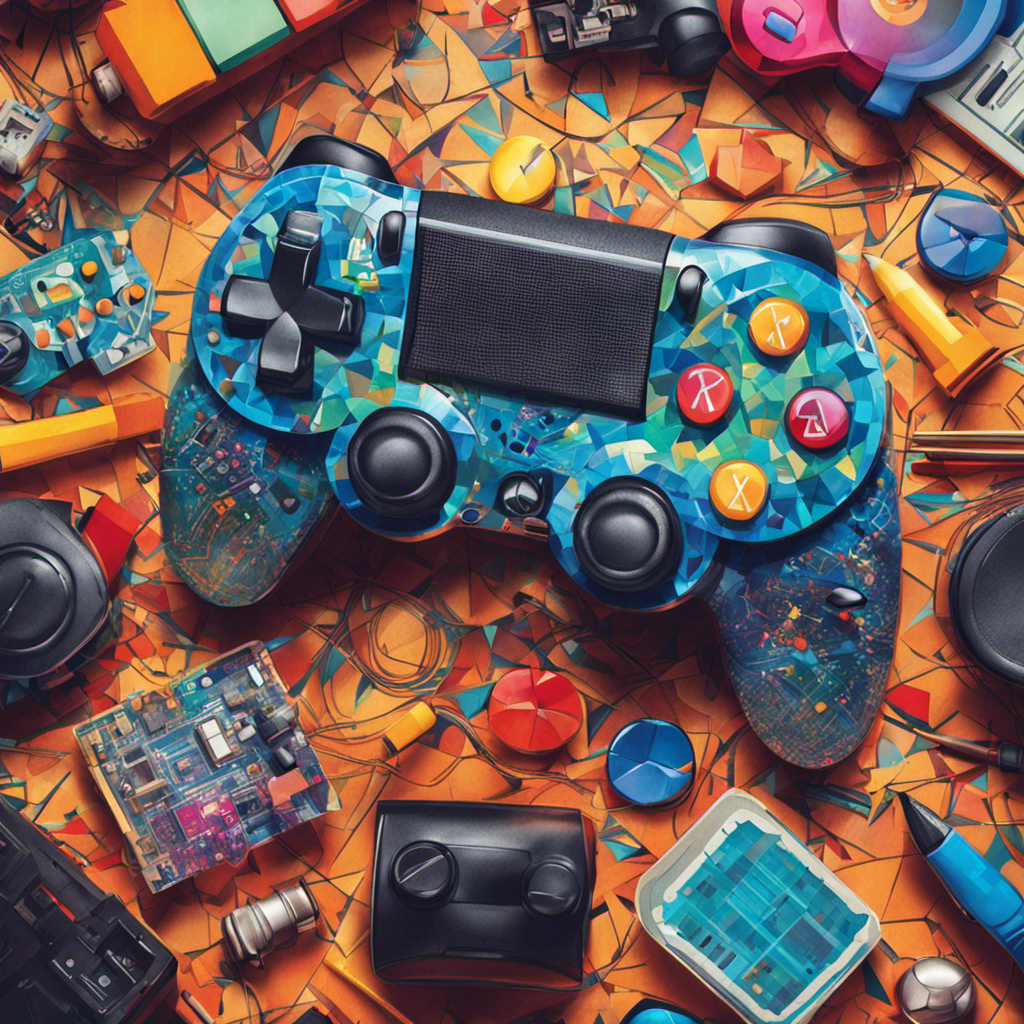Hey there!
Ever wondered what it’s like to be a game designer? Get ready to dive into the fascinating world of these creative masterminds.
In this article, we’ll explore the role of game designers in the industry, their educational background, and the skills that make them so incredibly talented.
We’ll also take a look at some famous game designers and the challenges they face.
So buckle up and get ready for some mind-blowing fun facts about game designers that will leave you inspired and craving more!
Key Takeaways
- Game designers are responsible for creating immersive experiences and carefully crafting every aspect of a game.
- Most game designers have a background in computer science or related fields and can build an impressive portfolio to showcase their creativity and technical expertise.
- Famous game designers like Shigeru Miyamoto and Hideo Kojima have made revolutionary contributions to the gaming industry and inspire aspiring game designers.
- Game designers face challenges such as limited resources, tight deadlines, player engagement, balancing gameplay challenge and reward, and technical limitations.
Role of Game Designers in the Industry
You’re probably wondering what role game designers play in the industry. Well, let me tell you, they are the visionary architects of virtual worlds, the masterminds behind the immersive experiences that captivate and engage players like yourself.
Game designers have a profound impact on player engagement by carefully crafting every aspect of a game – from its mechanics and gameplay to its narrative and aesthetics. They understand the importance of creating compelling characters, challenging puzzles, and exciting quests that keep you coming back for more.
In game development, game designers hold a pivotal position. They collaborate with artists, programmers, sound engineers, and other professionals to transform their ideas into interactive realities. Their innovative thinking pushes boundaries and challenges conventions in order to create groundbreaking gaming experiences that resonate with players like you.
So next time you find yourself engrossed in a captivating video game world, remember that it is all thanks to the brilliant minds of game designers who have dedicated themselves to crafting unforgettable adventures just for you.
Educational Background of Game Designers
Most game designers have a background in computer science or a related field. To embark on this exciting journey, you can explore various game design programs that offer comprehensive courses to hone your skills.
These programs provide a platform for aspiring designers like yourself to learn about game mechanics, storytelling, and level design. As you progress through the program, you will have opportunities to create your own games and build an impressive portfolio that showcases your creativity and technical expertise.
Your portfolio is your ticket to the industry, where employers search for innovative minds who can bring their visions to life. Remember, being a game designer means belonging to a community of passionate individuals who share the same love for creating immersive experiences.
So dive into the world of game design, let your imagination soar, and make your mark in this influential field!
Common Skills and Talents of Game Designers
Developing strong problem-solving skills is essential for game designers. It allows you to overcome challenges and create innovative solutions within the realm of interactive entertainment. To excel in this field, you must embrace game design principles and unleash your creative problem-solving abilities.
Here are three key skills that will help you thrive as a game designer:
- Adaptability: As technology advances at a rapid pace, being adaptable is crucial. You need to stay updated with new tools and techniques, adapting your problem-solving strategies to fit the ever-evolving landscape of game design.
- Collaboration: Game design is rarely a solitary endeavor. Collaborating with artists, programmers, and other team members fosters an environment of collective creativity. Embrace collaboration as a means to unlock new ideas and approaches.
- Iteration: The ability to iterate on ideas is vital in game design. By constantly refining and improving your work through multiple iterations, you can create games that resonate with players on a deeper level.
Embrace these skills wholeheartedly, and watch your designs transform into captivating experiences that leave players longing for more.
Famous Game Designers and Their Contributions
So, you want to delve into the world of influential game designers and their iconic creations? Prepare to be amazed as we take you on a journey through the minds of these visionaries who have shaped the gaming industry.
From the innovative designs of Shigeru Miyamoto, creator of Super Mario and The Legend of Zelda, to the revolutionary work of Hideo Kojima, mastermind behind Metal Gear Solid, get ready to explore the genius behind some of your favorite games.
Get ready to be inspired by these trailblazers who have left an indelible mark on gaming history.
Influential Game Designers
One of the most influential game designers today is Shigeru Miyamoto. As a game designer, you play a pivotal role in shaping the industry and creating memorable experiences for players. Your innovative ideas and visionary approach can change the way people interact with games.
However, being a game designer also comes with its fair share of challenges. You have to constantly push boundaries, think outside the box, and adapt to ever-changing technology and player expectations. Balancing creativity with practicality can be tricky at times, but it’s what makes your work so impactful.
Remember that you belong to a community of passionate individuals who share your love for gaming and want to see it thrive. Together, we can overcome any challenge and continue to shape the future of gaming.
Iconic Game Creations
You’ve learned about influential game designers who have shaped the gaming industry. Now, let’s dive into the captivating world of iconic game creations and explore the unique characters that have captured our hearts.
These iconic game characters are not just pixels on a screen; they are the embodiment of creativity and imagination. From Mario, the mustachioed plumber with a knack for saving princesses, to Lara Croft, the fearless explorer delving into treacherous tombs, each character has left an indelible mark on gaming history.
But what makes these characters so memorable? It all comes down to game design principles that prioritize relatability and immersion. Developers meticulously craft compelling narratives, intuitive controls, and visually stunning worlds to create unforgettable experiences.
As you journey through these virtual realms alongside these beloved characters, remember that their creation is a testament to the power of game design in fostering a sense of belonging and adventure within us all.
Challenges Faced by Game Designers
If you’re a game designer, challenges such as limited resources and tight deadlines can be common hurdles. But fear not, for in the world of game design, every challenge is an opportunity for creative problem-solving techniques to shine.
Here are five challenges faced by game designers that will test your innovation and push you to create groundbreaking experiences:
- Limited resources: Embrace constraints and find innovative ways to maximize what you have.
- Tight deadlines: Let the pressure fuel your creativity and streamline your workflow.
- Player engagement: Craft experiences that captivate players and make them feel like they belong in your virtual worlds.
- Balancing gameplay: Strike the perfect balance between challenge and reward to keep players hooked.
- Technical limitations: Find inventive solutions to work within the limitations of hardware or software.
As a visionary game designer, these challenges will only fuel your passion for creating unique and immersive gaming experiences.
Future Trends in Game Design
Get ready to step into a new dimension of gaming. The future of game design is here, and it’s all about immersive experiences.
Virtual reality integration allows you to fully immerse yourself in the game world, blurring the lines between reality and fantasy.
With AI-driven game mechanics, your virtual opponents will become smarter and more challenging than ever before, adapting to your every move.
And if that wasn’t enough, cross-platform multiplayer experiences will connect gamers from all corners of the globe, creating a truly global gaming community.
The future of gaming is bright, and it’s time for you to be at the forefront of this revolution.
Virtual Reality Integration
Virtual reality integration has revolutionized the way game designers create immersive gaming experiences. With advancements in VR technology, players can now fully immerse themselves in virtual worlds, feeling as if they are a part of the game itself. This has had a profound impact on player immersion, creating an unparalleled level of engagement and excitement.
| Advancements | Impact on Player Immersion |
|---|---|
| Realistic Graphics | Players feel like they are inside the game world as visuals become more lifelike and detailed. |
| Interactive Environments | The ability to interact with objects and manipulate the virtual world enhances the sense of presence and realism. |
| Spatial Audio | Surround sound audio techniques make players feel like sounds are coming from all directions, further immersing them in the game environment. |
| Natural Movement | VR controllers and body tracking allow players to physically move within the game space, increasing their sense of embodiment. |
| Multiplayer Experiences | Collaborative gameplay in VR creates a strong sense of social belonging among players, fostering a community-like atmosphere. |
With these advancements, virtual reality integration is transforming gaming into an incredibly immersive experience where players truly belong within their favorite games.
Ai-Driven Game Mechanics
AI-driven game mechanics have revolutionized the way we interact and engage with virtual worlds. They provide us with dynamic and unpredictable experiences, taking gaming to new heights. These cutting-edge technologies immerse us in richly detailed environments that adapt to our every move. Each playthrough is unique, as the intelligent algorithms respond and evolve based on our actions.
But along with the thrilling gameplay experiences, there are ethical implications to consider in AI-driven game design. As AI becomes more sophisticated, questions arise about the moral responsibility of developers and the potential for unintended consequences. How do we ensure fair and unbiased outcomes? Should AI be allowed to make decisions that could impact a player’s experience or even their real-life emotions?
As the gaming industry continues to push boundaries with AI-driven game mechanics, it is crucial for designers and players alike to navigate these ethical dilemmas together. By fostering open dialogue and embracing transparency, we can shape a future where technology enhances our sense of belonging within virtual worlds without compromising our values.
Cross-Platform Multiplayer Experiences
Cross-platform multiplayer experiences have become increasingly popular, allowing players to connect and compete with friends across different gaming platforms. It’s an exciting time for game design, especially for mobile platforms.
The rise of cross-platform play has opened up new possibilities and challenges for game designers. With the ever-growing smartphone market, game developers need to consider how their games will function on these devices, optimizing the gameplay experience for smaller screens without sacrificing quality.
Collaborative game design processes are crucial in this endeavor, as teams work together to create seamless cross-platform multiplayer experiences that provide a sense of belonging and connection among players.
Frequently Asked Questions
How Do Game Designers Collaborate With Other Professionals in the Industry?
Game designers collaborate with other professionals in the industry through various collaborative techniques, such as brainstorming sessions and team meetings. They also attend networking events to connect with artists, programmers, and sound designers, fostering a sense of belonging within the gaming community.
What Are the Most Common Misconceptions About Game Designers?
Misconceptions about game designers often arise due to a lack of understanding. It’s important to recognize the challenges they face, such as balancing creativity and technical constraints. Embrace their innovative spirit and contribute to a sense of belonging in the gaming community!
How Does the Cultural Background of Game Designers Influence Their Work?
Your cultural background shapes your game design. Diverse experiences bring fresh perspectives, leading to innovative and inclusive games. Embrace the impact of diverse backgrounds on game development, and watch your creations transcend boundaries.
What Are Some Lesser-Known Game Design Tools That Professionals Use?
To create mind-blowing games, game designers like you utilize cutting-edge game design software and employ prototyping techniques that push the boundaries of innovation. Become a part of this visionary community and explore new horizons!
How Do Game Designers Balance Creativity With the Need for Commercial Success?
Balancing artistry with profits is a challenge for game designers. You must be creative while also meeting market demands. It’s about finding the sweet spot where your unique vision resonates with players and brings commercial success.
Conclusion
As you reflect upon the captivating world of game design, you realize the immense impact and creativity that game designers bring to the industry.
From their diverse educational backgrounds to their extraordinary skills, these visionaries shape our gaming experiences in ways we never thought possible.
Their contributions have forever changed the landscape of gaming, and as challenges arise, they rise above them with innovative solutions.
With future trends on the horizon, game designers will continue to push boundaries and create immersive worlds that captivate our imaginations.
Get ready for an exciting future in game design!





